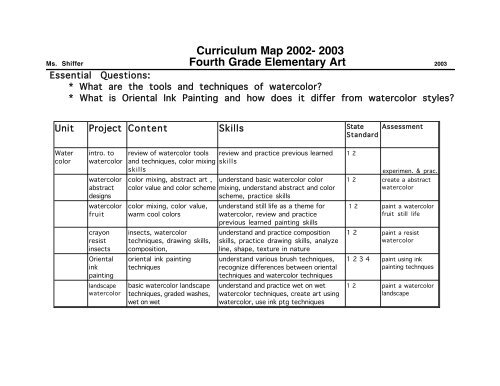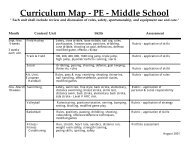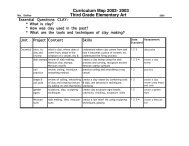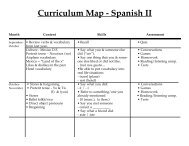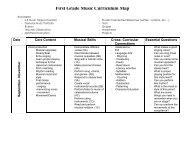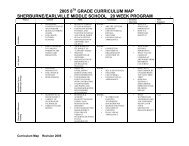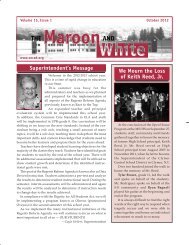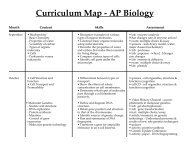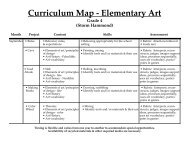Curriculum Map 2002- 2003 Fourth Grade Elementary Art
Curriculum Map 2002- 2003 Fourth Grade Elementary Art
Curriculum Map 2002- 2003 Fourth Grade Elementary Art
Create successful ePaper yourself
Turn your PDF publications into a flip-book with our unique Google optimized e-Paper software.
<strong>Curriculum</strong> <strong>Map</strong> <strong>2002</strong>- <strong>2003</strong>Ms. Shiffer <strong>Fourth</strong> <strong>Grade</strong> <strong>Elementary</strong> <strong>Art</strong> <strong>2003</strong>Essential Questions:* What are the tools and techniques of watercolor?* What is Oriental Ink Painting and how does it differ from watercolor styles?Unit Project Content Skills StateStandardAssessmentWatercolorintro. towatercolorwatercolorabstractdesignsreview of watercolor toolsand techniques, color mixingskillscolor mixing, abstract art ,color value and color schemereview and practice previous learnedskillsunderstand basic watercolor colormixing, understand abstract and colorscheme, practice skills1 2experimen. & prac.1 2 create a abstractwatercolorwatercolorfruitcolor mixing, color value,warm cool colorsunderstand still life as a theme forwatercolor, review and practiceprevious learned painting skills1 2 paint a watercolorfruit still lifecrayonresistinsectsinsects, watercolortechniques, drawing skills,composition,understand and practice compositionskills, practice drawing skills, analyzeline, shape, texture in nature1 2 paint a resistwatercolorOrientalinkpaintingtechniqueslandscapewatercolororiental ink paintingtechniquesbasic watercolor landscapetechniques, graded washes,wet on wetunderstand various brush techniques,recognize differences between orientaltechniques and watercolor techniquesunderstand and practice wet on wetwatercolor techniques, create art usingwatercolor, use ink ptg techniques1 2 3 4 paint using inkpainting technques1 2 paint a watercolorlandscape
Essential Questions:<strong>Curriculum</strong> <strong>Map</strong> <strong>2002</strong>- <strong>2003</strong>Ms. Shiffer <strong>Fourth</strong> <strong>Grade</strong> <strong>Elementary</strong> <strong>Art</strong> <strong>2003</strong>* What is Origami?* Why is Origami a unique style of sculpture?Unit Project Content Skills StateStandardAssessmentOrigamiOrigamiOrigamidigital presentation ofOrigami identify Origami asan ancient art form, basicfolding understand skills basic Origamifolding skills, createOrigamiidentify Origami as an ancient art form,understand and practice basic foldingskills3 4 discussionunderstand basic Origami folding skills 1 2 create Origamisculptures
<strong>Curriculum</strong> <strong>Map</strong> <strong>2002</strong>- <strong>2003</strong>Ms. Shiffer <strong>Fourth</strong> <strong>Grade</strong> <strong>Elementary</strong> <strong>Art</strong> <strong>2003</strong>Essential Questions:* What are the techniques of drawing?* How do artists use the techniques of drawing to create space?Unit Project Content Skills StateStandardAssessmentDrawinggesturedrawingwackywormscontourlines onions,gourds andpumpkinsDrawingskillsforeshort.DrawingskillsoverlappingformsDrawingbottle stilllifestill lifedrawingsgesture drawing andsketching, analyzing formand movementedge and contour line, colorvaluecontour line and formdrawing 3D forms, reviewof foreshortening, cylindersand cubesdrawing 3D forms,overlapping and size,proportion, diminishingperspectivedrawing still life objectsusing cylinders and cubespractice drawing skills,value, texture,foreshortening, etc.understand what gesture drawing is,understand movement as a principle ofart1 2 practice gesturedrawingsunderstand edge and contour line 1 2 create designsusing contour linesand color valuecontour line drawing skills, analyzecontour in still life objectsreview and practice foreshorteningdrawing skills,understand overlapping as a means ofcreating the illusion of depthunderstand how to use cylinders, cubesand foreshortening to draw real objects,analyze shape and form in a still lifeobject create drawings using new and previouslearned skills1 2 use new andprevious learneddrawing skills tocreate a drawing1 2 create drawingsusing forshortening& geometric forms1 2 create drawingsusing overlapping,and sizeporportions1 2 draw bottles usinggeometric form &foreshortening1 2 draw a still lifeusing learneddrawing skills
<strong>Curriculum</strong> <strong>Map</strong> <strong>2002</strong>- <strong>2003</strong>Ms. Shiffer <strong>Fourth</strong> <strong>Grade</strong> <strong>Elementary</strong> <strong>Art</strong> <strong>2003</strong>Drawingcont.portraitdrawings,facialdimensionsselfportraitsreview of portrait drawingskills, facial dimensions,front, side and 3/4practice and review portrait drawing 1 2 create a portraitdrawingself portraits, pastels practice previous learned drawing skills 1 2 create a selfportrait drawingone pointperspectivetwo pointperspectiveabstractlandscapes,spaceone point perspective,two point perspective,creating space and depth,vertical perspective,diminishing perspective,atmospheric perspectiveunderstand and use one pointperspectiveunderstand and use two pointperspectivereview of basic perspective concepts,recognize space as an art elementEssential Questions:* What are the seven Elements of Design?* How do artists use the Elements of Design in to create art?1 2 create drawingsusing one pointperspective1 2 create drawingsusing two pointperspective1 2 create a landscapeusing various typesof perspectiveUnit Project Content Skills StateStandardAssessmentDesignart elementreviewline, shape, color, value,texture, space, formreview and identify art elements, obtaina basic understanding of what they are1 2 3 discussionlines,characteristicsline characteristics, moodsand personalityunderstand that different types of lineconvey different personality1 2 create a designshowing linepersonality
eview texture, space, form a basic understanding of what they arelines,characteristicsline characteristics, moodsand personalityunderstand that different types of lineconvey different personality<strong>Curriculum</strong> <strong>Map</strong> <strong>2002</strong>- <strong>2003</strong>1 2 create a designshowing linepersonalityMs. Shiffer <strong>Fourth</strong> <strong>Grade</strong> <strong>Elementary</strong> <strong>Art</strong> <strong>2003</strong>Designcont.lines, formand planesLines, parallel, planes,constructive lines, formunderstand that line creates shape andform1 2 create a designusing parallel linesthat create planesdecorativelineslines, pattern, various typesof line (short, long)understand that lines can createdecorative patterns1 2 create art usingdecorative linelines andshapelines andtexturelines create shape, organic,manmade shapeline, texture, using line tocreate textureunderstand and identify shape, recognizedifferences in types of shaperecognize and identify texture,understand that line can create texture1 2 create designsusing line andshape1 2 create art usingtexturetexture andnaturevalue andformcolor andvaluefinding texture in organicand natural forms, still lifevalue, shape and form, lightsource and shadingcolor and valueunderstand and analyze texture innatural form,understand the difference between shapeand form, use value to create form,understand how light source effects formand value, create art using value tounderstand that value is a characteristiccreate of color, form create art using colors andtheir values1 2 3 create still lifedrawings usingtexture andprevious learned1 2 create art showingdrawing skillsvalue and form1 2 create art showingcolor value
<strong>Curriculum</strong> <strong>Map</strong> <strong>2002</strong>- <strong>2003</strong>Ms. Shiffer <strong>Fourth</strong> <strong>Grade</strong> <strong>Elementary</strong> <strong>Art</strong> <strong>2003</strong>Essential Questions:* How can computers be used as an artists tool?* What drawing skills can be used with computer draw programs?Unit Project Content Skills StateStandardAssessmentComputerartIntro. tocomputerartKidpix techniques, drawingskills, computer skillsreview various drawing skills andcomputer techniques available in Kidpix1 2 discussioncolorkaleidoscopescolor and color wheels,review and practice the color wheel,create a color wheel design using thecomputer1 2 create acolorwheel on thecomputerouter spacelandscapeforeshortening skills,landscape, texture, shading,one point perspectivecreate a space scape using drawing skillsand the computer1 2 create a spacelandscape on thecomputertextureplanetstexture, speres,overlapping, porportioncomputer tools, previously learneddrawing skills, creating texture1 2 create textureplanets with thecomputerdinosaurslandscape perspective,texture, dinosaurscomputer draw tools, previously learnedperspective skills1 2 create landscapeswith thecomputerRain Forestanimalsrain forest animals, drawingskills, computer skillscreate artwork using computer skillsand previously learned drawing skills1 2 create rainforestdrawings on thecomputer
<strong>Curriculum</strong> <strong>Map</strong> <strong>2002</strong>- <strong>2003</strong>Ms. Shiffer <strong>Fourth</strong> <strong>Grade</strong> <strong>Elementary</strong> <strong>Art</strong> <strong>2003</strong>Essential Questions:* What is clay?* How does clay become a piece of ceramic art?* What are some ways to decorate a clay piece?Unit Project Content Skills StateStandardAssessmentCeramicsintro. toclay andreviewSouthwest.nativeAmericanpottery coil potsSouthwest.stylewhat is clay, where does itcome from, steps in thecreation of a vessel, dry &wet, Southwestern firing clay pottery,Maria Martinez, motifs andsymbolscoiling, shaping andsmoothing potteryunderstand where clay comes from andhow it becomes a piece of ceramic art,understand the firing processrecognize and identify SouthwesternPottery, Analyze designs, understandhow it was made, view Pottery videounderstand steps to making a coil andpinch pot2 3 4 discussion3 4 discussion1 2 3 4 make a coil andpinch potsmoothingandpolishingpolishing stones, smoothingtechniquescontinue to make a vessel 1 2 make a burnishedclay potdecoratingsouthwest.potterySouthwestern imagery andsymbols, slip painting,sgraffitocontinue to make a vessel 1 2 3 4 decorate a clay potwith slip &sgraffitoInuit claysculpturesInuit sculpture, sculptingtechniquessculpting techniques 1 2 3 4 make a claysculptureHaida tilesclay tiles, Haida art styles,relief sculptingtile making, recognize Haida art styles 1 2 3 4 make a clay tile


